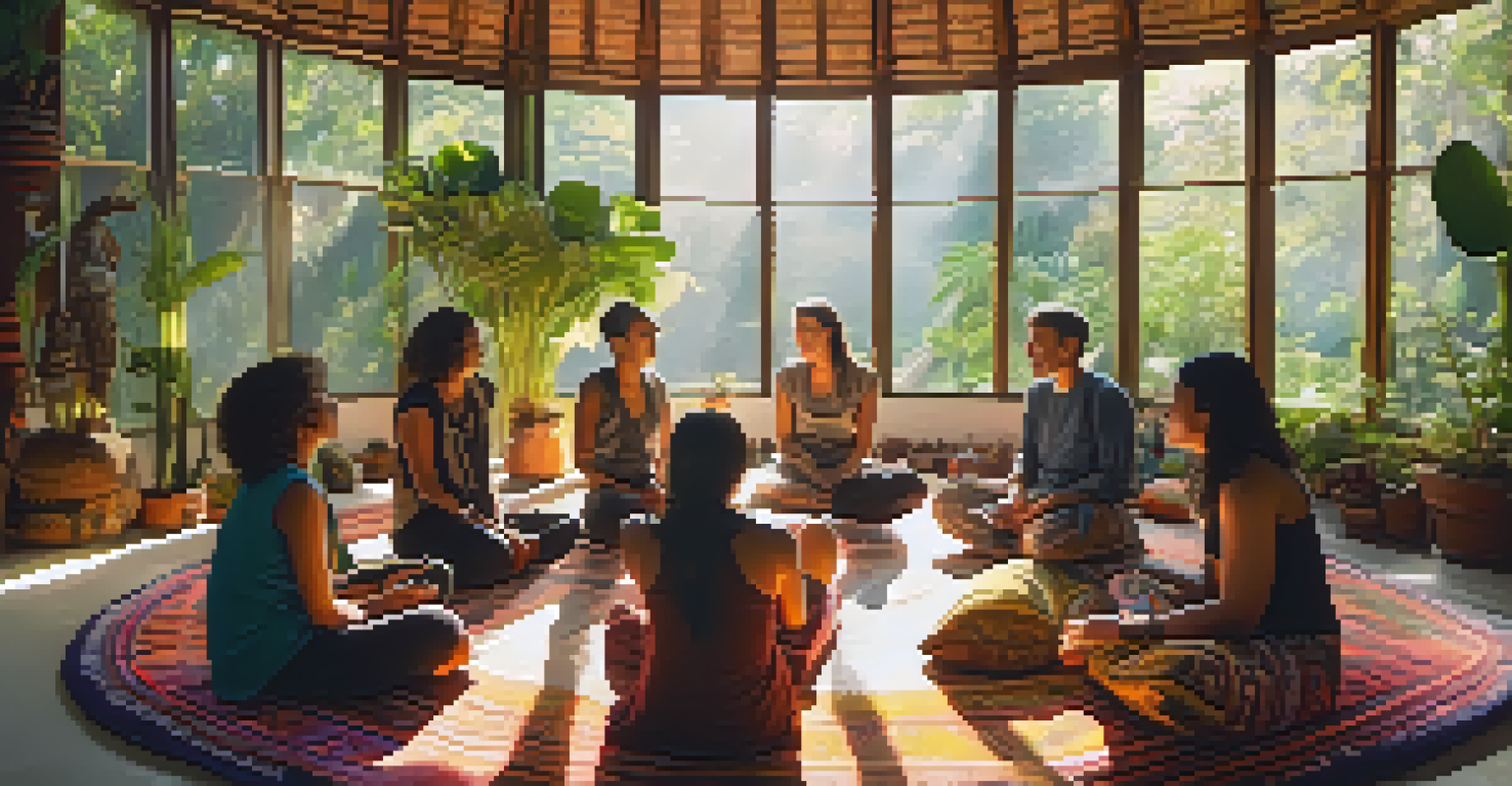Cultural Context: Setting and Ayahuasca's Transformative Power

Understanding Ayahuasca: A Brief Overview
Ayahuasca is a traditional plant-based brew originating from the Amazon rainforest, often associated with indigenous cultures. It typically combines two key ingredients: the Banisteriopsis caapi vine and the leaves of the Psychotria viridis shrub. This magical concoction has been used for centuries in spiritual rituals, aiming to connect participants with their inner selves and the universe at large.
The experience of Ayahuasca is a journey into the soul, where the real work begins after the ceremony ends.
The brew's psychoactive properties come mainly from DMT (dimethyltryptamine), a compound that induces vivid visions and deep introspection. These experiences can lead to significant emotional and psychological healing, making Ayahuasca a powerful tool for many seeking transformation. It's essential to approach this journey with respect, understanding its cultural significance and the intentions behind its use.
In recent years, Ayahuasca has gained popularity beyond the Amazon, drawing people from all walks of life. However, this surge in interest raises questions about cultural appropriation and the commercialization of indigenous practices. Recognizing Ayahuasca's roots is vital for appreciating its true transformative potential.
Cultural Significance of Ayahuasca in Indigenous Communities
For many indigenous tribes in the Amazon, Ayahuasca is not just a substance; it's a sacred medicine integral to their spiritual practices and cultural identity. Shamans, or spiritual healers, guide participants through ceremonies, using the brew to facilitate healing, divination, and community bonding. This deep-rooted tradition emphasizes the importance of connection to nature and the spiritual world.

The rituals surrounding Ayahuasca are often elaborate, involving music, chanting, and the participation of the community. These elements work together to create a safe space for individuals to explore their consciousness, confront personal challenges, and find clarity. The communal aspect also reinforces social ties, promoting healing not just at the individual level but for the entire community.
Ayahuasca's Cultural Importance
Ayahuasca serves as a sacred medicine for indigenous communities, playing a vital role in their spiritual practices and cultural identity.
As interest in Ayahuasca spreads globally, it highlights the need to honor and respect its origins. Engaging with indigenous leaders and understanding their perspectives is crucial in ensuring that this practice is preserved and respected in its true form.
The Role of Setting in the Ayahuasca Experience
The setting in which Ayahuasca is consumed plays a pivotal role in shaping the experience. Traditional ceremonies are typically held in natural environments, surrounded by the lush greenery of the Amazon rainforest. This connection to nature enhances the spiritual journey, allowing participants to feel more grounded and in tune with their surroundings.
Ayahuasca is a profound teacher that reveals the interconnectedness of all things.
In contrast, consuming Ayahuasca in a commercialized or non-traditional setting can detract from its transformative power. When the ambiance is not aligned with the sacredness of the experience, participants may find it challenging to connect with the brew on a deeper level. Thus, creating a respectful and tranquil environment is essential for fostering meaningful insights.
Additionally, the presence of experienced facilitators can significantly impact the experience. They help guide participants through their journeys, providing support and reassurance when challenging emotions arise. This nurturing approach helps create a safe space for healing and self-discovery.
Ayahuasca as a Tool for Personal Transformation
Many individuals turn to Ayahuasca seeking personal transformation, whether it’s to confront past traumas, break harmful patterns, or gain clarity on life decisions. The brew often catalyzes profound realizations, allowing participants to see their lives from new perspectives. These insights can foster a sense of empowerment and motivation to enact positive changes.
Participants often report experiencing intense emotional releases during their journeys. These cathartic moments can lead to healing and a renewed sense of purpose. For some, Ayahuasca becomes a crucial part of their personal growth journey, aiding them in navigating life's complexities with greater clarity and resilience.
Setting Affects Ayahuasca Experience
The environment in which Ayahuasca is consumed significantly impacts the journey, with traditional settings enhancing the transformative experience.
However, it's important to approach Ayahuasca with the understanding that it's not a magic cure-all. Transformation is a process that requires ongoing commitment and integration of the insights gained during the experience. Support systems, such as therapy or community groups, can be invaluable in this transition.
The Science Behind Ayahuasca's Effects
Recent studies have begun to explore the science behind Ayahuasca and its effects on the brain. Research indicates that DMT, the key psychoactive component, may promote neurogenesis, which is the growth of new neurons. This could potentially explain the long-lasting positive changes in mood and perspective that many users report after their experiences.
Additionally, Ayahuasca has been linked to reductions in symptoms of depression, anxiety, and PTSD. While more research is needed to understand the full scope of its therapeutic potential, initial findings suggest that the brew may help individuals reprocess traumatic experiences and develop healthier coping strategies. This scientific interest reinforces the idea that Ayahuasca can serve as a bridge between ancient wisdom and modern healing practices.
However, understanding the science behind Ayahuasca also necessitates a holistic approach that includes its cultural and spiritual dimensions. Recognizing the interplay between the mind, body, and spirit can lead to a more profound appreciation of Ayahuasca's transformative power.
Challenges and Misconceptions Surrounding Ayahuasca
As Ayahuasca gains popularity, various misconceptions and challenges have emerged. One common myth is that Ayahuasca is purely recreational or a quick fix for personal issues. In reality, the experience can be intense and daunting, often requiring participants to face uncomfortable truths about themselves. It's essential for potential users to approach Ayahuasca with respect and an understanding of its profound nature.
Another challenge is the rise of unregulated Ayahuasca retreats, which can exploit vulnerable individuals seeking healing. Not all facilitators are adequately trained, and some may not honor the cultural context of the brew. This underscores the importance of thorough research and choosing reputable, culturally respectful retreats led by experienced guides.
Integration Is Key After Ayahuasca
Successfully integrating insights from an Ayahuasca experience into daily life is crucial for lasting personal transformation.
Additionally, the stigma surrounding psychedelics can create barriers to open discussions about Ayahuasca. Many people remain unaware of its potential for healing due to societal misconceptions. Increasing awareness and education about Ayahuasca’s benefits and risks is crucial for fostering a more informed and respectful dialogue.
Integrating Ayahuasca Experiences into Daily Life
After an Ayahuasca journey, integrating the insights gained into daily life can be both rewarding and challenging. Many participants find that the experience sheds light on aspects of their lives that require change, prompting them to take actionable steps toward improvement. However, the transition from profound spiritual insight to everyday reality can be difficult without proper support.
Establishing practices such as journaling, meditation, or joining integration circles can facilitate this process. These activities encourage reflection and help individuals make sense of their experiences, allowing them to apply lessons learned in meaningful ways. Building a supportive community is equally important, as sharing experiences with others can provide valuable perspectives.

Ultimately, the integration process is a personal journey, and everyone’s path will look different. By being patient and compassionate with oneself, individuals can foster growth and transformation that lasts long after the Ayahuasca experience has ended.